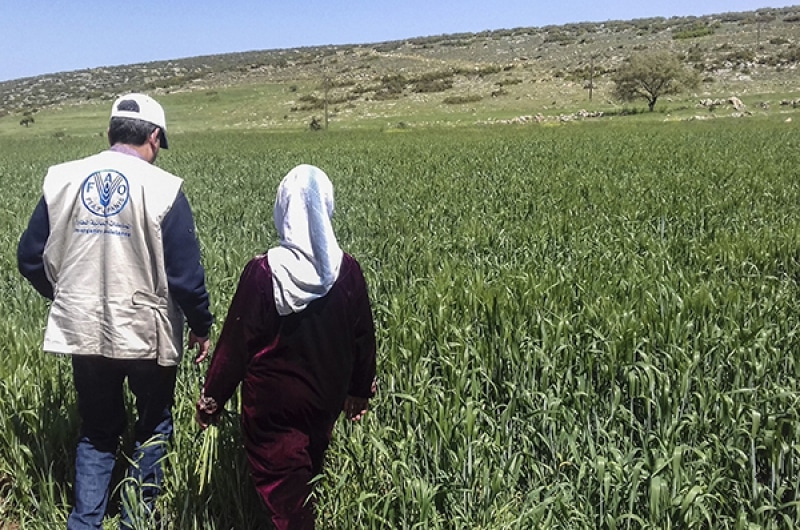Pubblicato il 8 Settembre 2022
Syria’s devastated agriculture, suffering peasants and farmers – a study on water scarcity
di Joseph Daher

In 2019 Syria’s annual water needs, including for agricultural, industrial and domestic use, were estimated at about 12.9 billion m3, with agriculture consuming between 86% and 89%. Water scarcity and pollution are having negative impacts on agricultural and food production and on livestock rearing. At the same time, water supply has increasingly become a source of concern for Syrians as result of the spread of diseases, and also constitutes a rising cost.
The war and its consequences resulted in the destruction of irrigation structures and pumping stations, which alongside recurrent erratic electricity outages and rising fuel prices, triggered a substantial reduction in the areas under irrigation. The irrigated area for industrial crops, such as cotton and sugar beet, which necessitate processing factories, many of which were damaged or destroyed, also decreased dramatically.
Nevertheless, with the restoration of irrigation infrastructure there have been modest improvements in recent years in the area of irrigable land, which passed from 1.42 million hectares in 2019/20 to 1.44 million hectares in 2020/21. Irrigation is primarily used for wheat, vegetables, cotton, potatoes, sugar beet and citrus fruit. The agriculture sector today remains highly dependent on irrigation because of irregular rainfalls, particularly in the northern governorates of the country: al-Hasaka, Aleppo and Raqqa, and Deir al-Zor along the Euphrates. The large number of irrigation canals destroyed has led farmers and peasants to over-exploit even more groundwater and build new unregistered ones.
The increase in the use of groundwater wells, in addition to lowering the water table, has increased the salinity of the water, which as a result has lowered yields. In addition, farmers in the northeast have lost entire crop fields as seasonal rains have flooded the polluted canals, creeks and rivers, disseminating fuel oil over thousands of hectares of land. In this context, damaged irrigation infrastructure, scarce rainfall, the lack of fuel and the increasing cost of production have reduced the production of cotton, wheat and fruit (apples, cherries, apricots, citrus fruit, etc.).
For instance, the amount of citrus fruit production decreased by 27.3% between 2016 and 2021. This reduction resulted from a failure to secure the required quantities of irrigation water to grow and develop the fruit, in addition to a decline in dam stock, according to Director of the Citrus Office at the Ministry of Agriculture, Engineer Suhail Hamad. The effects of climate change have also had a clear impact on agricultural production in general and on citrus fruit in particular, as a consequence of longer periods of drought. As was previously mentioned, most Syrian cereal cultivation is rainfed and is therefore sensitive to weather shocks and climate volatility.
Similarly, wheat production in 2022 has been estimated at a very low level, approximately 1.05 million tonnes as in 2021, compared to 2.8 million in 2020 and a pre-crisis average of 4.1 million tonnes (between 2002 and 2011), while the need in regime-held areas is around 3 million tonnes. Lastly, cotton production has also suffered a harsh reduction, from 472,000 tonnes in 2010 to 72,000 tonnes in 2022, which has pushed the government to authorise cotton imports since July 2021.
This commodity represents the backbone of the country’s textile industry. Farmers with difficult access to irrigation water have increasingly been dependent on purchasing water in tankers, which is, however, difficult to provide in certain areas and very expensive (see below). The lack of water resources and the rise in the general cost of production (especially for fuel oil and fertilisers) have pushed some farmers to cease their activity and leave their lands for other livelihood opportunities, while others have accumulated high levels of debts or seek a second job to cover their agricultural expenses.
The cost of cultivating a dunum passed from between SYP 10,000 and 30,000 (equivalent to between USD 4 and 12) at the beginning of 2022 to around SYP 700,000 (equivalent to USD 249) in May.59 Water scarcity and pollution have also affected the health and quantity of livestock in the country,60 together with other reasons such as smuggling, population displacement, a lack of animal feed and a reduction in veterinary services. The number of sheep, for instance, has diminished by around 30%, from 18 million in 2010 to less than 15 million in 2020. In 2021 water access for animals was restricted in various areas of Hama, al-Hasaka, the Syrian desert (al-Badia) and in Deir al-Zor, which witnessed shrinking river water levels.
This situation resulted in higher water pollution levels and a proliferation of insects and germs that triggered diseases among animals. Water rainfall and reserves are continual growing problems for Syrian agriculture. The impact of climate change on Syria will increase in the next years with more recurrent and intense severe weather events and shifting temperatures and precipitation patterns.
In this context, farmers have used various strategies to try to cope with water scarcity. For instance, there has been a progressive switch by some farmers in certain areas from irrigation and intensive farming to rainfed subsistence farming, while others have transformed their cropping systems to cultivating rainfed barley and wheat instead of vegetables such as peas, potatoes and cabbages, which need to be irrigated all year.
The continual degradation and damage in water treatment networks have increased the proportion of Syrians depending on often unsafe alternatives to piped water, which reached 47% in 2022 from 38% in the previous year. Wastewater has been discharged untreated into the natural environment resulting in serious risks to public health and significantly contaminating groundwater resources.
In this context, water pollution and tankers selling unlicensed water (around 1,000 litres generally) have resulted in the dissemination of numerous diseases such as leishmaniasis in Aleppo and Deir al-Zor and typhoid fever around Damascus.
Joseph Daher
You can read the full report including notes at this link here













Rivista di Antropologia Culturale, Etnografia e Sociologia dal 2011 – Appunti critici & costruttivi